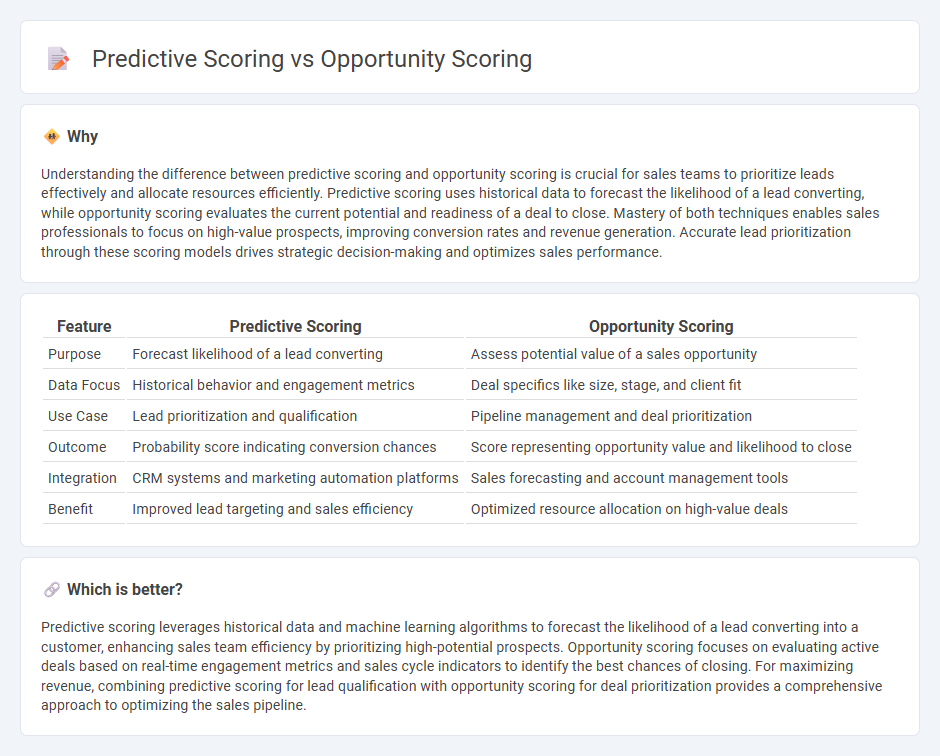
Predictive scoring leverages machine learning algorithms to analyze historical customer data, identifying patterns that forecast future buying behavior with high accuracy. Opportunity scoring evaluates potential sales deals based on real-time factors such as customer engagement, deal stage, and competitive landscape to prioritize efforts effectively. Explore the differences and benefits of predictive and opportunity scoring to enhance your sales strategy.
Why it is important
Understanding the difference between predictive scoring and opportunity scoring is crucial for sales teams to prioritize leads effectively and allocate resources efficiently. Predictive scoring uses historical data to forecast the likelihood of a lead converting, while opportunity scoring evaluates the current potential and readiness of a deal to close. Mastery of both techniques enables sales professionals to focus on high-value prospects, improving conversion rates and revenue generation. Accurate lead prioritization through these scoring models drives strategic decision-making and optimizes sales performance.
Comparison Table
| Feature | Predictive Scoring | Opportunity Scoring |
|---|---|---|
| Purpose | Forecast likelihood of a lead converting | Assess potential value of a sales opportunity |
| Data Focus | Historical behavior and engagement metrics | Deal specifics like size, stage, and client fit |
| Use Case | Lead prioritization and qualification | Pipeline management and deal prioritization |
| Outcome | Probability score indicating conversion chances | Score representing opportunity value and likelihood to close |
| Integration | CRM systems and marketing automation platforms | Sales forecasting and account management tools |
| Benefit | Improved lead targeting and sales efficiency | Optimized resource allocation on high-value deals |
Which is better?
Predictive scoring leverages historical data and machine learning algorithms to forecast the likelihood of a lead converting into a customer, enhancing sales team efficiency by prioritizing high-potential prospects. Opportunity scoring focuses on evaluating active deals based on real-time engagement metrics and sales cycle indicators to identify the best chances of closing. For maximizing revenue, combining predictive scoring for lead qualification with opportunity scoring for deal prioritization provides a comprehensive approach to optimizing the sales pipeline.
Connection
Predictive scoring leverages historical sales data and machine learning algorithms to forecast the likelihood of leads converting into customers, while opportunity scoring evaluates current deals' potential value and probability of closing. Both scoring methods utilize CRM data to enhance sales pipeline management and prioritize high-impact prospects. Integrating predictive and opportunity scoring drives data-driven decision-making, improving sales forecasting accuracy and accelerating revenue growth.
Key Terms
Opportunity Scoring:
Opportunity scoring evaluates potential leads or deals by identifying gaps and areas for improvement, assessing factors such as product fit, customer needs, and buying signals. Unlike predictive scoring, which relies heavily on historical data and algorithms to forecast outcomes, opportunity scoring emphasizes strategic insights and actionable opportunities within sales pipelines. Explore how opportunity scoring can enhance your sales strategy and drive higher conversion rates.
Qualification Criteria
Opportunity scoring evaluates leads based on predefined qualification criteria such as budget, authority, need, and timeline (BANT), ensuring alignment with ideal customer profiles. Predictive scoring leverages machine learning algorithms to analyze historical data and identify patterns that indicate a lead's likelihood to convert, often incorporating variables beyond explicit qualifications. Discover how refining qualification criteria can enhance your scoring strategy for better sales outcomes.
Lead Prioritization
Opportunity scoring evaluates leads based on their fit and engagement, helping prioritize those most likely to convert, while predictive scoring uses data-driven algorithms and machine learning to forecast future sales outcomes more precisely. Lead prioritization benefits from integrating both methods to balance qualitative insights with quantitative predictions, optimizing sales strategies and resource allocation. Discover more to enhance your lead management and increase conversion rates effectively.
Source and External Links
What Is Opportunity Scoring and How to Calculate It - Opportunity scoring is a method used in product management to prioritize feature development by evaluating user importance and satisfaction with features, helping teams identify areas for improvement.
What is Opportunity Scoring? - Opportunity scoring is a strategy for prioritizing feature development by identifying features that are important to customers but underdeveloped or unsatisfying, offering potential for increased customer satisfaction.
Opportunity Scoring - Opportunity scoring helps teams focus on customer outcomes by scoring their importance and satisfaction, highlighting areas with the greatest potential for innovation and improvement.
 dowidth.com
dowidth.com